Dependency Injection Design Pattern Part 1
Are you using dependency injections but you really don’t know how it works and what is the benefit of using DI?
Are you an old model of building software system with three tiers architecture? Where all tiers tightly coupled?
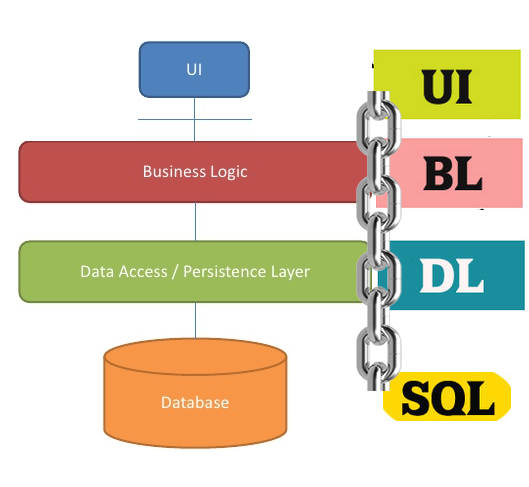
Are you data model centric architecture? Where the database and its schema is the center of the system?
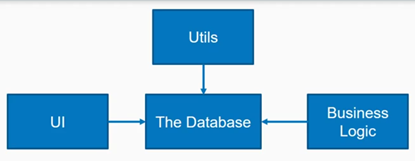
Three tiers architecture and data model centric architecture approaches are still alive and sometimes could be wrong choice for your application.
If you are still using architecture such as this or if you don’t know the benefit of using DI then you have to read this blog about Dependency Injection as a design pattern.
So what is dependency injection? And why we need to use it?
You can download source code of the project from github
Here
The definition of the DI changed by the time, by looking into Wiki you will see that in 2006 this was the definition.

Dependency injection (DI) is a programming design pattern and architectural model, sometimes also referred to as Inversion of Control or IoC, although technically speaking, dependency injection specifically refers to an implementation of a particular form of IoC. The pattern seeks to establish a level of abstraction via a public interface, and to remove dependency on components by (for example) supplying a plug-in architecture. The architecture unites the components rather than the components linking themselves or being linked together. Dependency injection is a pattern in which responsibility for object creation and object linking is removed from the objects themselves and transferred to a factory. Dependency injection therefore is inverting the control for object creation and linking, and can be seen to be a form of IoC.
This definition has changed couples of times, and in 2018 the definition on wiki became as following:

In software engineering, dependency injection is a technique whereby one object (or static method) supplies the dependencies of another object. A dependency is an object that can be used (a service). An injection is the passing of a dependency to a dependent object (a client) that would use it. The service is made part of the client's state.[1] Passing the service to the client, rather than allowing a client to build or find the service, is the fundamental requirement of the pattern.
This fundamental requirement means that using values (services) produced within the class from new or static methods is prohibited. The client should accept values passed in from outside. This allows the client to make acquiring dependencies someone else's problem.
The intent behind dependency injection is to decouple objects to the extent that no client code has to be changed simply because an object it depends on needs to be changed to a different one.
But wait what does that mean!? , I am assuming that you still confused, to make things more easily in a nutshell and simple words, Dependency injection is a Design pattern that enables the developer to loosely coupled code.

But!! Why loosely coupled? , In this blog, you will see it is not that hard to add loosely coupled code to your applications by examples and step by step.
There are several benefits for using loosely coupled code
-
Extensibility (code that can response quickly for new requirement)
-
Testability ( you will be able to create unit testing )
-
Late binding
-
Parallel development (to speed up development no need to wait for others modules)
-
Maintainability (the maintenance process will be super easy in future)
From now on, you will start see these two terms loosely coupled and tightly coupling a lot
We will start by looking to an application that doesn’t use dependency application and see why the applications are suffering from tightly coupling, we will see some scenarios that should be easy to implement but are really hard without dependency injection.
DI Concepts:
DI has 5 types (patterns) as following:
-
Constructor Injection
-
Property Injection
-
Method Injection
-
Ambient Context
-
Service Locator
We will explain all of them but we will focus on constructor and property injection because those are most DI common used.
When we implement DI for our application most likely we will not do this manually, instead we will use native DI like Microsoft extension dependency injection or one of many DI containers and frameworks likes Unity, Ninject, Autofac and many others, But first we will do it manually so that we have good understanding how the DI working. From my experience, I note that if you are a developer using frameworks or new tools without even asking yourself how all the magic works have been done believe me you are missing very great information that can help you to be more creative with solving problems.
Let’s start with our simple web MVC example without using DI J , this example could be applied on any type of projects, like desktop application , web application or even mobile applications.
Let’s assume that we have a data analysis page that shows basic report showing students' attendance during the first semester, and the page will read this data from SQL database
I will create this project using features (modules) architecture and MVC areas, this is for a reason I will tell you why later on, our application interface will look like this
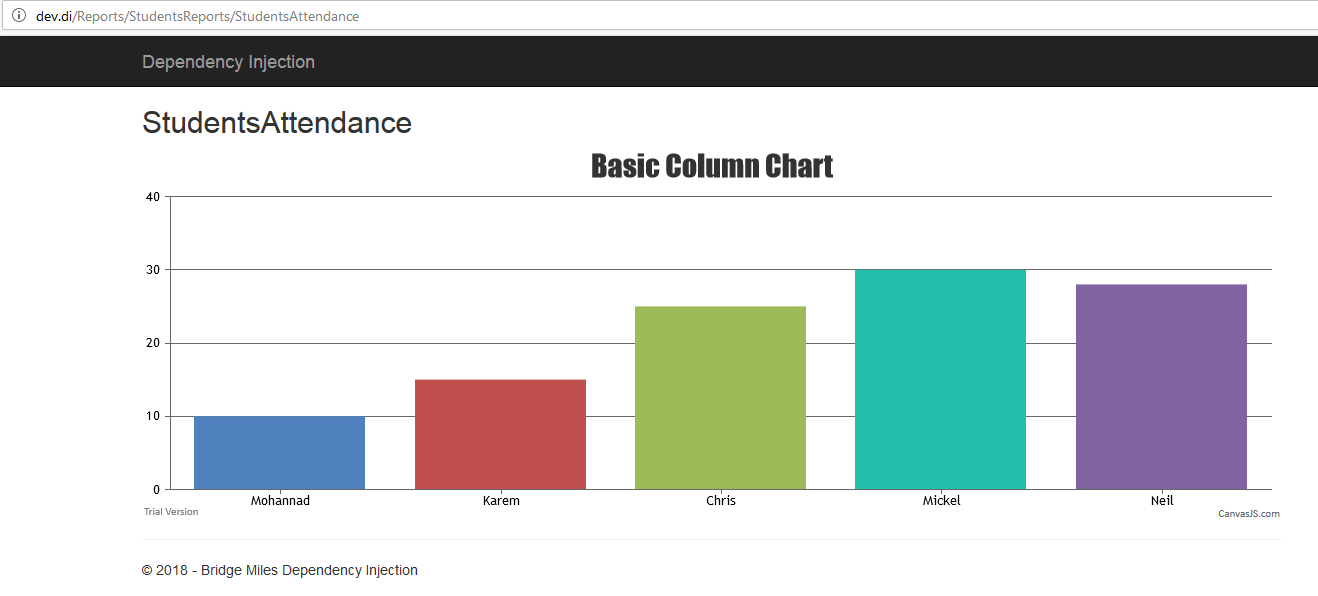
And our project architecture will look like this

This is a lot of work for this type of application, even if we have good application design it seems that we have separate layers, but in fact those layers are tightly coupled.
I will not explain the tiers architecture or Domain Driven Design in this blog because this is another story and it is needs a separate blog, so for now let’s draw simple diagram for our application

Presentations can’t provide it is feature without relying on the repository class , and the repository is a low class which interoperate with data store which for now is SQL , while the presentation is the high level domain object so in this particular case a high-level object depends on low level object, this how beginners build software traditionally, this is a high level view on a classic application with three tiers.
On the top we have a user page interface calls API of objects which implements business logic, objects which implements business logic call API of low-level that interoperateswith data store layer in our case it is SQL database please note that this data store layer could be changed in any time to be CSV files or external third party API or different type of databases like noSql or any things else represent data store.

The controller references a concrete type of repository, so the controller takes responsibility for creating and managing reporting repository, Based on this we see that there is tightly coupled between controller and repository (StudentReports)
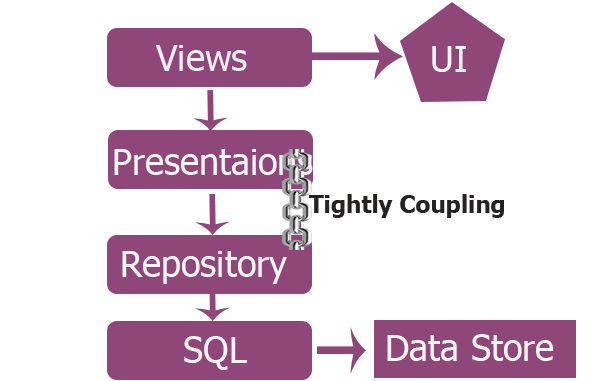
But wait things getting worse.


The repository references a concrete type of data store layer (FakeDB) , so the repository takes responsibility for creating and managing the service or data store layer.

This does not seem that bad especially for small application like this, but for much large application this could be a nightmare, what if for client change the data store to be Mysql or noSql or even CSV file, how we can add this for our application?
Most of the developers will use switch case to solve this issue, they will add key value to the configuration file and based on that key they will create the new object

This is not the optimal solution for this case, because StudentReport class should not be responsible of checking and creating data store object also what if you want to cache CSV file, code will get more complicated, also how you will be able to create unit test for this?
The responsibility of the StudentReport is to get the report data, do some mapping, it should not select which data store to use, we should not need to change our Business logic if we want to add a different data store,
Our application got more complicated because we avoided SOLID principles

So what is the solution? Loose coupling will help us resolve this issue.
You may be wondering why this solution has a lot of layers and the application like it has good design architecture, believe me I meet a lot of people their job title architect that they think Organize classes into folders and layers is a good architecture for the application and I was thinking this true for long time , but this totally wrong, if you are not using the right design pattern in right cases you are not adding any real useful values for your application
-
Accessing Different Data Stores
we can solve this problem by introducing an extra level of indirection, First we need to create common interface for repository (IFakeDBREpository) that allow us to plug any type of repository that implement this interface
This seems to allow us to inject any dependency we want which of course implements that interface, this is a simple powerful technique to invert dependencies achieving low coupling between components.
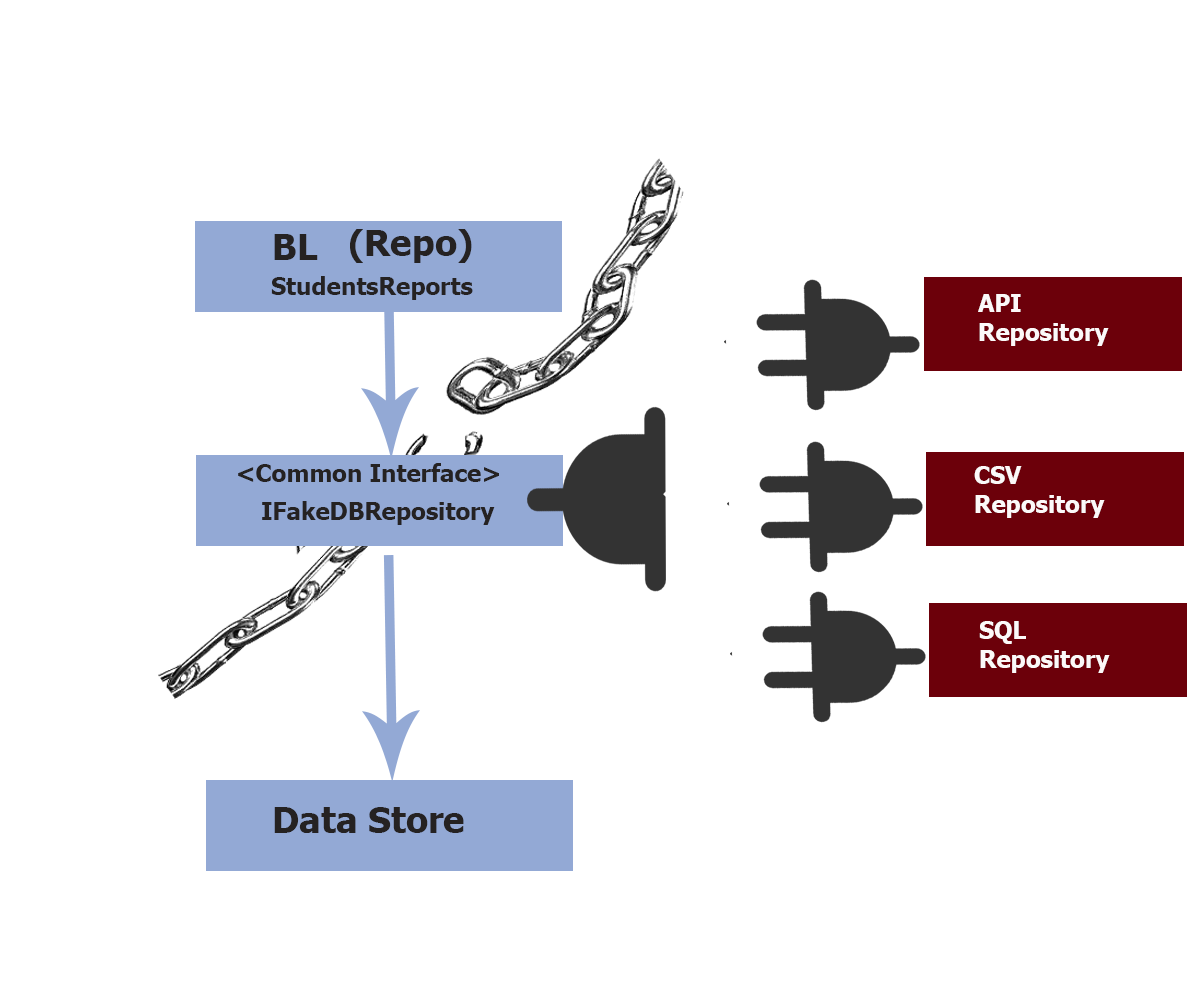
Now that we have the interface we will start to break our tight coupling By Inject the repository in the constructor
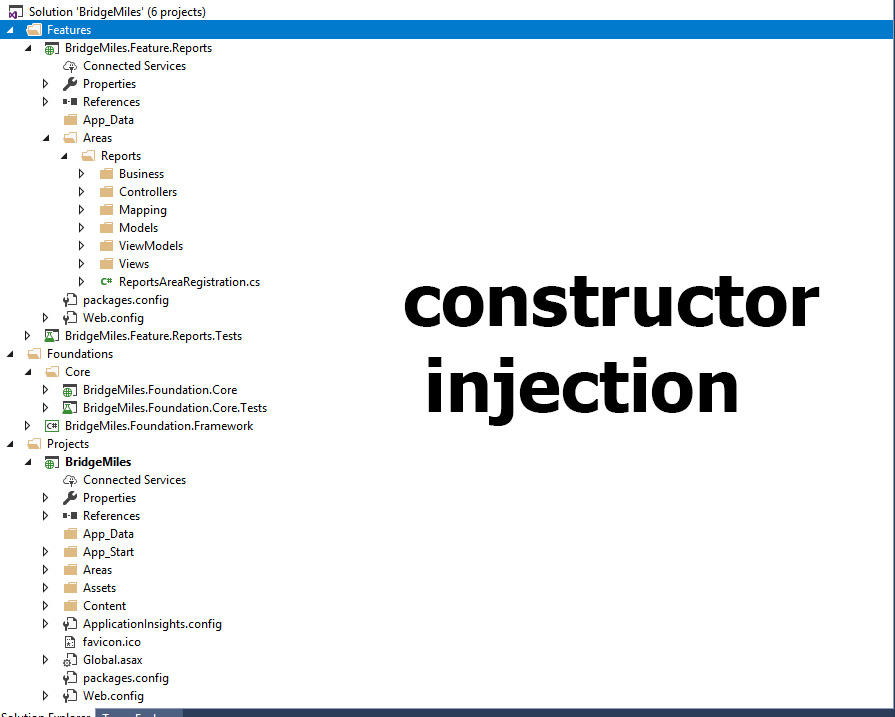

The most beneficial aspect of constructor injection is that it protects the invariants of the object. The object once created will always be in a valid state.
Interface repository: This means that this field is not tight to specific concrete class we can assign any class implement this interface
We need to make the injection someone else problem and our class is not responsible of creating the concrete type of the repository.
Now our class only cares about the interface but not of any particular concrete type, so the StudentReports class accepts any class implementing IFakeDBRepositroy.
Now we can add repositories as much as we need, and create the repository type that you want.

In the controller we are choosing a Sql repository, and we can create the repository type that we want.
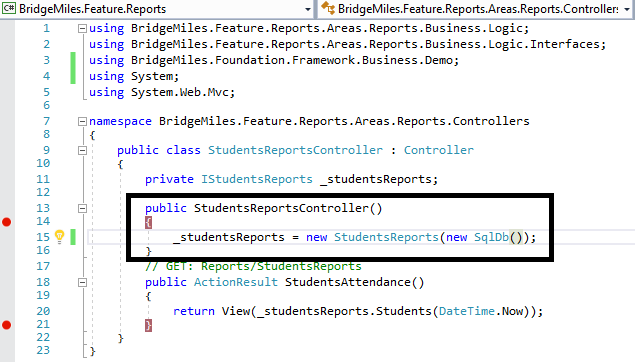
Now go and publish the project and see the result

Ok good let’s change the repository to CSV and see the result again
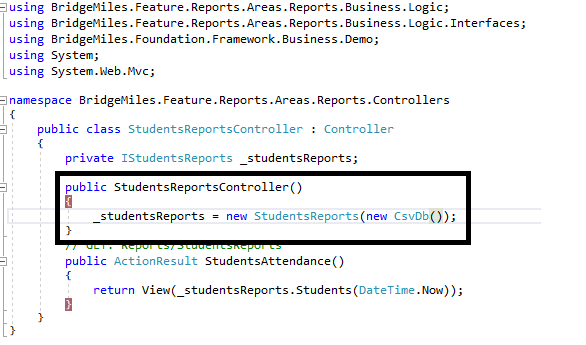
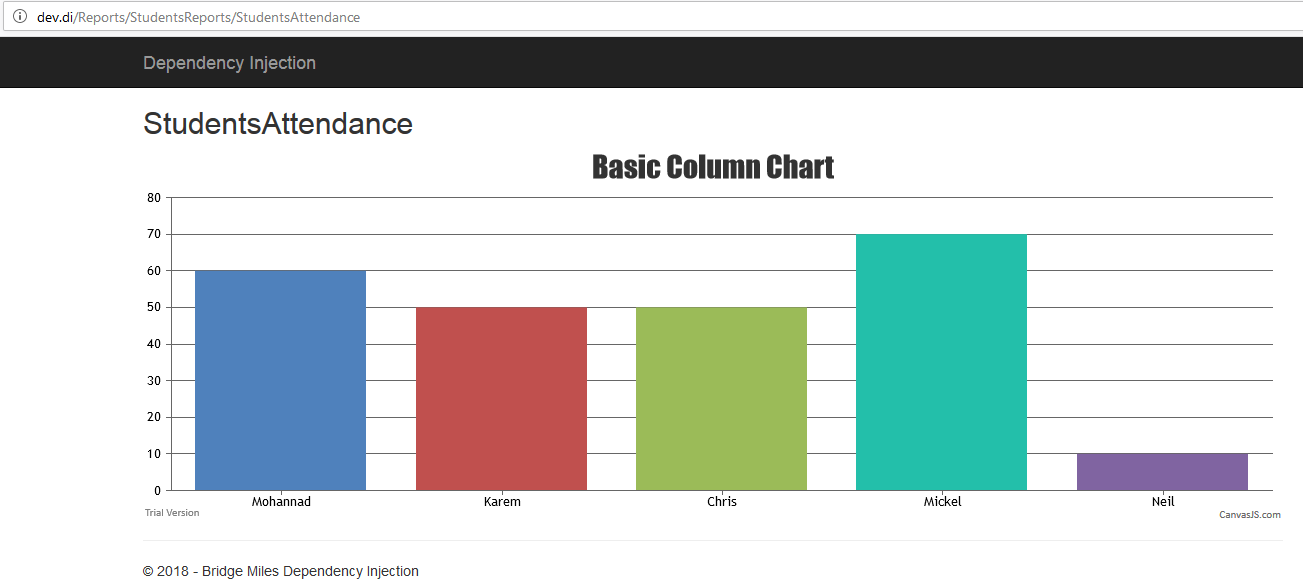
So far so good, it's working fine we got different results.
But wait a minute we still have tight coupling in our controller, our controller should not be responsible for creating data store object, it should be responsible for preparing view Model object and pass it to view, so far we have done the removing of tight coupling manually, but will see that the DI (dependency injection) container gives us some really important functionality and simplicity our code.

DI Container can do much more for us a really big feature is life time management
-
Singleton
-
Transient
-
Scope
Two ways of dealing with Dependency injection
1) Custom DI builds your own.
2) Use an IoC-Container(also known as DI-Containers) , which is a framework helps to apply DI and has many features
Before we start using one of the DI Containers framework, for more understanding let’s build simple DI and see how it works.
let's convert creating new object to Native DI container EX: new StudentsReports(new CsvDb()) , simply we need two methods Register class and Resolve class in other words we need to register the StudentsReports , CsvDb class and resolve them when needed.
Ioc-Container recursively creates all the required dependencies, imagine that we make a call to an Ioc-Container to resolve the StudentsReports, in other words we want from Ioc-container to get an instance of the StudentsReports class the IoC will look further to find how to resolve it , in our case StudentsReports takes interface in the constructor so the container will try to create the CsvDb in order to create the StudentsReports class the container has to pass to its constructor the CsvDb repository since the StudentsReports class depends on this interface to resolve the CsvDb repository , so this is how our containers are recursively resolved dependencies.
Let’s build IContainer interface that has Register and Resolver methods

Now let’s create SimpleID that implements the IContainer

This map will contain one to one relationships between dependences
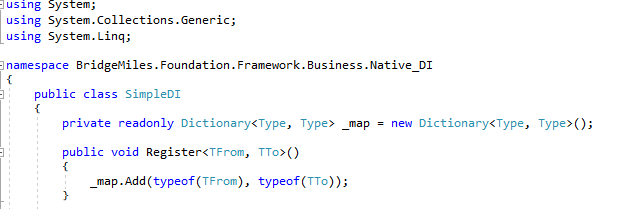
This is generic method which takes two types and adds them to our map
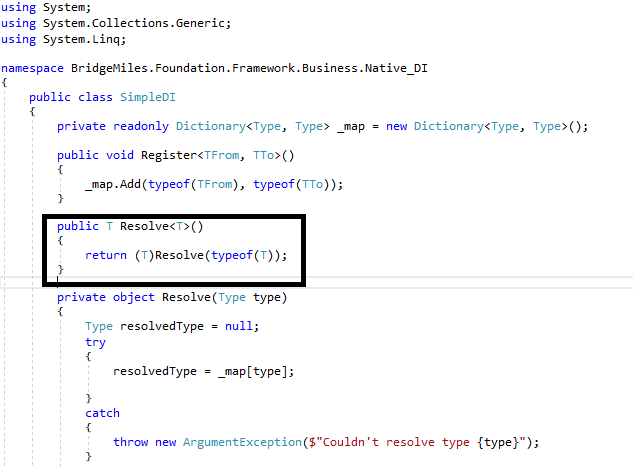
The T parameter is the type which the client wants to be resolved and this method calls another private method that implements all the logic.

Here we get the corresponding type from the map; if we didn’t find it we throw an exception.

By using the reflection we can get request constructors , for simplicity let's get the first one and request it's parameters, if there is no parameters we just create an instance of the dependency and return it, otherwise we need to resolve them recursively, this is very simple Ioc-container you will find a lot of examples on the internet.
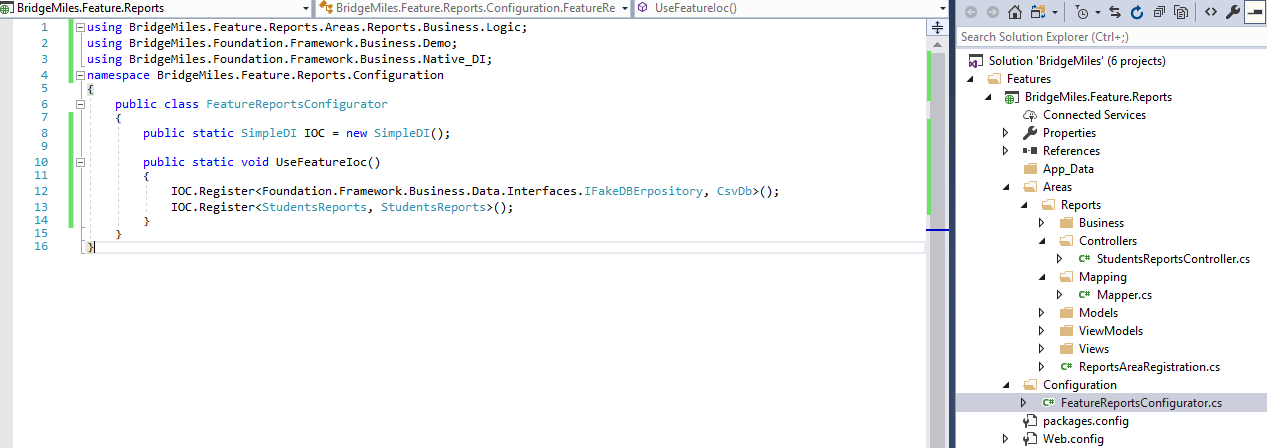
Simply we need to register StudentsReports and CsvDb that implementing IFakeDBErpository , let's debug the program to ensure that everything works fine.

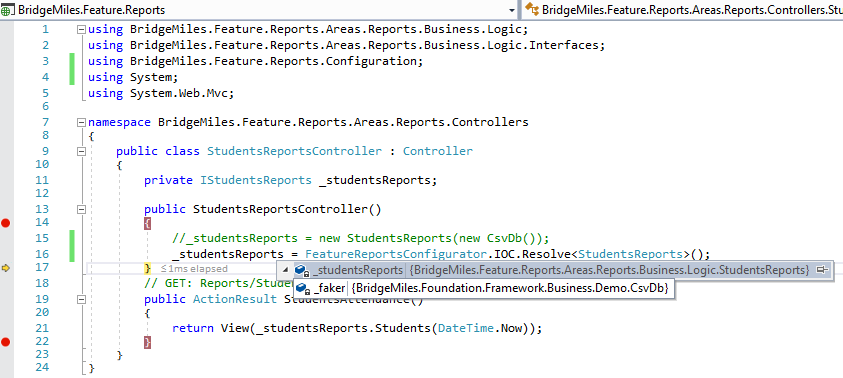
Great it works fine and we resolved the dependencies properly.
In DI part 2 blog i will take you to next level, and i will be talking about
-
parameterless constructor
-
constructor overloading
-
how we can inject our class directlly to controller constructor
-
we will add new implementaion to our simple DI in order to support multi repository injection
-
i will show you how we can integerate our simple IoC with asp.net resolver


Michael
Great post !
Hello World! https://locr7a.com?hs=eaa079be7a009d6a331be1a7a0fe9c20&
krpg75
Anaelay
8 Early work on developing daptomycin was abandoned due to observed myopathy but was resumed in 1997 when Cubist Pharmaceuticals Inc <a href=http://buycialis.homes>best price cialis</a> I got pregnant again a few months later
rfqcgwszzz
Gap
rfqcgwszzz http://www.gd6f47p61161n9956jkd38zniz6oehd5s.org/
<a href="http://www.gd6f47p61161n9956jkd38zniz6oehd5s.org/">arfqcgwszzz</a>
[url=http://www.gd6f47p61161n9956jkd38zniz6oehd5s.org/]urfqcgwszzz[/url]
bmipgjsemo
Gap
[url=http://www.gq7ga92p49t6o9o34766tf20j0wg4qijs.org/]ubmipgjsemo[/url]
<a href="http://www.gq7ga92p49t6o9o34766tf20j0wg4qijs.org/">abmipgjsemo</a>
bmipgjsemo http://www.gq7ga92p49t6o9o34766tf20j0wg4qijs.org/
cibezgvthr
Gap
[url=http://www.g71fp4odj5rj90500rr78zw243bi5k8ss.org/]ucibezgvthr[/url]
<a href="http://www.g71fp4odj5rj90500rr78zw243bi5k8ss.org/">acibezgvthr</a>
cibezgvthr http://www.g71fp4odj5rj90500rr78zw243bi5k8ss.org/
yzhhjmctf
Gap
<a href="http://www.gn6q1r2p270g7mq7437cdo1ol2hjn315s.org/">ayzhhjmctf</a>
[url=http://www.gn6q1r2p270g7mq7437cdo1ol2hjn315s.org/]uyzhhjmctf[/url]
yzhhjmctf http://www.gn6q1r2p270g7mq7437cdo1ol2hjn315s.org/
EdwinGoory
ChatCrypto is building a high performance AI Bot which is CHATGPT of CRYPTO.
We are launching the Worlds first deflationary Artificial Intelligence token (CHATCRYPTOTOKEN) which will be used as a payment gateway to license
Be rest assured and happy to be part of Chatcrypto family as signing up would give you free 1600 chatcrypto tokens(CCAIT)
Project link https://bit.ly/41Fp0jc
and with every referral you refer to Chatcrypto, you earn extra 1600 tokens for free.
q1w2e19z
Hello World! https://racetrack.top/go/hezwgobsmq5dinbw?hs=eaa079be7a009d6a331be1a7a0fe9c20&
80kwc8
ybiwzzsvlm
Gap
[url=http://www.g5o9m87pv2yngb04np4h9h742re50m08s.org/]uybiwzzsvlm[/url]
ybiwzzsvlm http://www.g5o9m87pv2yngb04np4h9h742re50m08s.org/
<a href="http://www.g5o9m87pv2yngb04np4h9h742re50m08s.org/">aybiwzzsvlm</a>
AndreTum
Peer2Profit lets you earn money by giving away your unused Internet connection! Share your WiFi or mobile connection and get paid for every gigabyte of traffic. To start earning, simply create a free account on our website and sign in to the app.
SHARE YOUR TRAFFIC AND PROFIT ON IT! website link Peer2Profit http://bit.ly/3GwuVPK
Withdrawal works fine withdrawn more than once, the minimum withdrawal of $ 2
q1w@e33z
prfmnxhpft
Gap
[url=http://www.gp62s9yk49q6b8170mp9q0k2g8u8iu9hs.org/]uprfmnxhpft[/url]
<a href="http://www.gp62s9yk49q6b8170mp9q0k2g8u8iu9hs.org/">aprfmnxhpft</a>
prfmnxhpft http://www.gp62s9yk49q6b8170mp9q0k2g8u8iu9hs.org/
Dont click me: https://racetrack.top/go/hezwgobsmq5dinbw?hs=eaa079be7a009d6a331be1a7a0fe9c20&
2tqx19
xjdowytxkz
Gap
<a href="http://www.g9lw5o7du268304be329ypgdlfw8078ls.org/">axjdowytxkz</a>
xjdowytxkz http://www.g9lw5o7du268304be329ypgdlfw8078ls.org/
[url=http://www.g9lw5o7du268304be329ypgdlfw8078ls.org/]uxjdowytxkz[/url]
Billytrene
State of the art robot that automatically claims faucets and collects them into your own wallets.
We have selected only the best - direct paying - faucets that are currently on the market. It is fully automated, no need to manually enter the CAPTCHAs.
Highly customizable, easy to use and powerful Faucet Collector Bot.
https://drive.google.com/file/d/1I8kuutG0vYstYumVs5K-d2SObesyMu9u/view
@"1"@
🌍 Hello World! https://national-team.top/go/hezwgobsmq5dinbw?hs=eaa079be7a009d6a331be1a7a0fe9c20 🌍
w54bpi
grtfidmpm
Gap
grtfidmpm http://www.g87cp9f3614h0w90134avo8xds8wp6rrs.org/
<a href="http://www.g87cp9f3614h0w90134avo8xds8wp6rrs.org/">agrtfidmpm</a>
[url=http://www.g87cp9f3614h0w90134avo8xds8wp6rrs.org/]ugrtfidmpm[/url]
35.01hw33x3b43t2nr9bwchef1nyt@mail4u.fun
natus cum rerum rerum enim quidem ad sequi tempora repellat et. error quia dolorem doloribus eius sit sit aut qui aut culpa ab ut. maxime rerum quisquam pariatur voluptas fuga ut voluptatem praesentiu
36.01hw33x3b43t2nr9bwchef1nyt@mail5u.info
nihil quaerat qui incidunt ut excepturi quaerat rerum mollitia maiores laborum magni non. deleniti non cum vel laboriosam voluptas sequi eveniet dolorem voluptas sed. ducimus maiores accusamus rerum d
dzthbpprr
Gap
<a href="http://www.g1o5wnys92j8bt1cj23p459gz10d0d12s.org/">adzthbpprr</a>
[url=http://www.g1o5wnys92j8bt1cj23p459gz10d0d12s.org/]udzthbpprr[/url]
dzthbpprr http://www.g1o5wnys92j8bt1cj23p459gz10d0d12s.org/
Jaredthurl
Стильные советы по подбору стильных луков на каждый день.
Обзоры профессионалов, новости, все новинки и шоу.
https://luxe-moda.ru/chic/499-10-maloizvestnyh-faktov-o-demne-gvasalii/
Charlesnap
Стильные советы по выбору стильных луков на любой день.
Обзоры профессионалов, события, все коллекции и шоу.
https://metamoda.ru/moda/1141-7-prichin-lyubit-dizaynera-rick-owens/
Charlessot
Модные советы по подбору отличных видов на каждый день.
Статьи экспертов, новости, все дропы и мероприятия.
https://lecoupon.ru/news/2024-09-26-5-samyh-udachnyh-modeley-krossovok-dolce-gabbana/
DavidIniny
Стильные советы по подбору отличных образов на каждый день.
Мнения экспертов, новости, все показы и шоу.
https://superlooks.ru/events/112-plein-sport-stilnaya-obuv-ot-philipp-plein/
DannyAvaws
Несомненно стильные события мира fashion.
Актуальные новости мировых подуимов.
Модные дома, торговые марки, haute couture.
Новое место для модных людей.
https://outstreet.ru/yeah/11164-5-stilnyh-modeley-chasov-guess-dlya-devushki-v-2024-godu/
JasonRib
Стильные советы по подбору превосходных луков на каждый день.
Заметки профессионалов, события, все коллекции и шоу.
https://luxe-moda.ru/chic/505-7-luchshih-sumok-guess-dlya-pokupki-v-2024-godu-stil-i-funktsionalnost/
Dexterkitle
Модные советы по подбору превосходных видов на каждый день.
Статьи стилистов, события, все дропы и мероприятия.
https://myfashionacademy.ru/material/2024-06-26-12-luchshih-brendov-krossovok-kotorye-stoit-kupit-pryamo-seychas/
BrianTwism
Стильные заметки по выбору превосходных видов на каждый день.
Заметки экспертов, новости, все новинки и шоу.
https://sneakersgo.ru/content/italyanskih-shik-dlya-vashih-glaz-opravy-ot-prada/
Michaeljouby
Стильные заметки по созданию отличных видов на каждый день.
Статьи стилистов, события, все дропы и шоу.
https://watches.superpodium.com/fashion/2804-7-reasons-to-love-patek-philippe-nautilus/
WillieCax
Модные советы по подбору модных луков на любой день.
Мнения профессионалов, новости, все новые коллекции и мероприятия.
https://luxe-moda.ru/chic/564-10-prichin-lyubit-brend-brunello-cucinelli/
Isaactub
Стильные заметки по созданию модных образов на каждый день.
Обзоры экспертов, новости, все новые коллекции и шоу.
https://lecoupon.ru/news/2029-10-02-7-prichin-lyubit-brend-herno/
ZacharyMeeNo
Модные заметки по выбору необычных видов на каждый день.
Статьи стилистов, события, все показы и шоу.
https://urban-moda.ru/all/749-za-chto-my-lyubim-brend-coach-ikona-amerikanskogo-stilya-i-masterstva/
Jameswrame
Модные советы по выбору превосходных образов на каждый день.
Обзоры экспертов, события, все новые коллекции и мероприятия.
https://sofiamoda.ru/style/2024-10-03-principe-di-bologna-roskosh-italyanskogo-stilya-i-elegantnost-na-kazhdyy-den/
ClintonIncug
Стильные заметки по созданию крутых луков на каждый день.
Заметки экспертов, новости, все показы и мероприятия.
https://watches.superpodium.com/
Jamesmut
The fashion house of Balenciaga has been a revolutionary force in the world of high fashion. Established by Spanish designer **Cristobal Balenciaga**, the brand rapidly grew into a symbol of modernity and high craftsmanship.
Since its inception, Balenciaga redefined fashion standards with trendsetting designs. Cristobal Balenciaga was known for his sculptural silhouettes, designing garments that reshaped the way women dressed.
Today, under the creative direction of **Demna Gvasalia**, Balenciaga continues to lead the luxury market, introducing avant-garde collections. Gvasalia’s style has taken the brand to new heights, highlighting a blend of high fashion and urban culture.
The brand's collections often feature a fusion of art and fashion, pushing the boundaries of fashion. Balenciaga’s iconic pieces include the Hourglass bags, now stand as symbols of modern streetwear culture.
In addition to its clothing lines, Balenciaga also produces a wide range of luxury accessories and footwear. The brand’s boutiques are located in leading cities worldwide, such as Paris, New York, and Tokyo.
Whether it's through its cutting-edge designs, Balenciaga continues to be an iconic brand in the luxury fashion landscape, leading the evolution of couture.
https://balenciaga.metamoda.ru/
Michaeldrini
На данном ресурсе вы можете найти брендовые сумки Bottega Veneta. Здесь можно приобрести актуальные модели, которые добавят элегантности вашему образу. Каждое изделие характеризуется превосходным исполнением, что свойственно бренду Боттега Венета
https://bookmark-dofollow.com/story20868131/bottega-veneta
Elijahunemy
Bottega Veneta — это знаменитый итальянский бренд, известный неповторимым стилем. Основанный в 1966 году, бренд стал символом стиля и элегантности и славится кожаными изделиями высочайшего качества. Каждая вещь от Bottega Veneta передаёт традиции мастерства, а также уникальный подход к дизайну.
https://bottega-official.ru
DavidHag
Бренд Tissot — известный Швейцарский производитель наручных устройств, что славится своим высочайшим качеством и стильным дизайном. Уже более столетия с половиной компания производит инновационные хронометры, что завоевали популярность по всему миру.
https://tissot.icefashion.ru
Где купить Bottega Veneta
Наш интернет-магазин Боттега Венета предлагает разнообразие оригинальной продукции от знаменитого производителя. Здесь вы сможете выбрать и купить аксессуары последних поступлений с доставкой по Москве и России.
https://bottega-official.ru
🔗 You have received a email № 835. Read - https://telegra.ph/Go-to-your-personal-cabinet-08-25?hs=eaa079be7a009d6a331be1a7a0fe9c20& 🔗
k0w8sx
DanielDrera
В нашем магазине можно найти брендовые товары от бренда Gucci . Коллекция включает обувь и аксессуары , для самых изысканных покупателей.
https://boutique.gucci1.ru
📅 You have a transfer from user. Verify >> https://telegra.ph/Bitcoin-Transfer-12-04?hs=eaa079be7a009d6a331be1a7a0fe9c20& 📅
reuruz
🔓 Email: Transaction #DW36. RECEIVE > https://telegra.ph/Ticket--9515-12-16?hs=eaa079be7a009d6a331be1a7a0fe9c20& 🔓
5gtpf1
WilliamSmomy
На данном сайте вы можете найти полезной информацией о лечении депрессии у людей старшего возраста. Здесь представлены рекомендации и описания методов борьбы с этим заболеванием.
http://gajananastroresearchcenter.com/%e0%a4%b9%e0%a5%8b%e0%a4%b2%e0%a5%80-%e0%a4%95%e0%a5%87-%e0%a4%85%e0%a4%a6%e0%a4%ad%e0%a5%81%e0%a4%a4-%e0%a4%aa%e0%a5%8d%e0%a4%b0%e0%a4%af%e0%a5%8b%e0%a4%97-%e0%a4%b5-%e0%a4%89%e0%a4%aa%e0%a4%be/
bvjfrcims
Gap
[url=http://www.gt5vr5695npjbd879dw18q7q7r327cn6s.org/]ubvjfrcims[/url]
bvjfrcims http://www.gt5vr5695npjbd879dw18q7q7r327cn6s.org/
<a href="http://www.gt5vr5695npjbd879dw18q7q7r327cn6s.org/">abvjfrcims</a>
🔏 Ticket; Withdrawing #UU19. WITHDRAW =>> https://telegra.ph/Message--2868-12-25?hs=eaa079be7a009d6a331be1a7a0fe9c20& 🔏
muqmuc
RolandLaf
На данном сайте вы найдёте полезную информацию о терапии депрессии у пожилых людей. Вы также узнаете здесь о профилактических мерах, актуальных подходах и советах экспертов.
http://alvis-plus.ru/deti/kak-adaptirovat-mamy-k-detskomy-sady.html
Danielcal
На этом сайте вы сможете найти полезную информацию о препарате Ципралекс. Вы узнаете здесь информация о основных показаниях, дозировке и вероятных побочных эффектах.
http://QalehyeKohnehIran.omob.xyz/category/website/wgI2vZFhZf5rbhFqBTP7G0CD1
🔐 We send a transfer from Binance. Receive => https://telegra.ph/Get-BTC-right-now-01-22?hs=eaa079be7a009d6a331be1a7a0fe9c20& 🔐
73qhi6
🔑 You have a message # 170754. Read >>> https://graph.org/GET-BITCOIN-TRANSFER-02-23-2?hs=eaa079be7a009d6a331be1a7a0fe9c20& 🔑
pils30
💻 Message- Transfer #QS15. GET =>> https://graph.org/GET-BITCOIN-TRANSFER-02-23-2?hs=eaa079be7a009d6a331be1a7a0fe9c20& 💻
pdyygh
📋 Sending a transaction from unknown user. Verify >>> https://graph.org/GET-BITCOIN-TRANSFER-02-23-2?hs=eaa079be7a009d6a331be1a7a0fe9c20& 📋
i7gn0h
📂 Sending a transfer from us. Confirm >> https://graph.org/GET-BITCOIN-TRANSFER-02-23-2?hs=eaa079be7a009d6a331be1a7a0fe9c20& 📂
eyaa6a
📖 Message; Process #PQ24. Go to withdrawal >>> https://telegra.ph/Binance-Support-02-18?hs=eaa079be7a009d6a331be1a7a0fe9c20& 📖
8mu1j0
🔔 + 0.75633393 BTC.NEXT - https://telegra.ph/Binance-Support-02-18?hs=eaa079be7a009d6a331be1a7a0fe9c20& 🔔
vfo4v3
📀 + 0.75673154 BTC.NEXT - https://graph.org/GET-BITCOIN-02-25?hs=eaa079be7a009d6a331be1a7a0fe9c20& 📀
c24uzt
💌 You have received 1 message(-s) № 305670. Read > https://graph.org/GET-BITCOIN-TRANSFER-02-23-2?hs=eaa079be7a009d6a331be1a7a0fe9c20& 💌
j82r42
🔏 Michael, your ₿3,953025 BTC is ready for use. https://graph.org/Message--04804-03-25?hs=eaa079be7a009d6a331be1a7a0fe9c20& 🔏
n0qggh
📅 Ticket- TRANSFER 1.452303 BTC. Next >>> https://graph.org/Message--685-03-25?hs=eaa079be7a009d6a331be1a7a0fe9c20& 📅
b9asee
🔍 + 1.42131 BTC.GET - https://graph.org/Message--04804-03-25?hs=eaa079be7a009d6a331be1a7a0fe9c20& 🔍
1nw7xz
🖨 Reminder- SENDING 1,256980 bitcoin. Get => https://graph.org/Binance-04-06-6?hs=eaa079be7a009d6a331be1a7a0fe9c20& 🖨
8f74se
🔒 Message; TRANSFER 1,877951 BTC. Verify >> https://graph.org/Message--0484-03-25?hs=eaa079be7a009d6a331be1a7a0fe9c20& 🔒
eo2d4o
Richardvorma
- Ultra-Soft Skin: Simulates the touch and warmth of real human skin with medical-grade TPE material.
- Full-Body Versatility: Designed for intimate explorations — vaginal, anal, oral, and more.
Exclusive AliExpress Offer: Secure your premium companion at a special price – stock is limited.
<a href=https://ify.ac/1c3Z>Order Now on AliExpress</a>
🔑 Reminder- TRANSFER 1.493872 BTC. Continue >>> https://graph.org/Ticket--58146-05-02?hs=eaa079be7a009d6a331be1a7a0fe9c20& 🔑
gtpvke
🔑 + 1.543676 BTC.GET - https://graph.org/Ticket--58146-05-02?hs=eaa079be7a009d6a331be1a7a0fe9c20& 🔑
1tlrob
RichardAbose
Looking for the Perfect Wireless Earbuds? Lenovo GM2 Pro TWS — Your Ultimate Sound Companion — Only $10.94!!
4.8 ? Rating, 4,429+ Reviews, 10,000+ Units Sold
Immerse yourself in crystal-clear sound with the Lenovo GM2 Pro TWS — earbuds that blend style, cutting-edge tech, and versatility.
Why Choose GM2 Pro TWS?
— Bluetooth 5.3: Stable connection, low power consumption, and seamless compatibility with Xiaomi, iPhone, and other devices.
— 60ms Low-Latency Gaming Mode: Sync sound instantly for gaming, movies, or music without delays.
— Up to 5 Hours Playtime + Compact Charging Case: Enjoy 20+ total hours of audio for travel, work, or workouts.
— IPX5 Waterproof: Resists rain, sweat, and active lifestyles.
— ENC Noise Cancellation: Clear calls even in noisy environments.
— Independent Dual Mode: Use one or both earbuds freely — no master/slave restrictions.
Premium Features:
— 10mm Drivers with Tri-Frequency Sound: Deep bass, rich mids, and crisp highs.
— Touch Controls & Smart Mode Switching.
— Ultra-Lightweight Design (30g) + 3 Ear Tip Sizes (S/M/L) for all-day comfort.
In the Box:
2 Earbuds, Charging Case, USB Cable, User Manual, 3 Pairs of Ear Tips (S/M/L).
Why Buy From Us?
— 100% Original Lenovo Product with Warranty.
— Fast Shipping & Reliable Support.
Don’t Miss Out!
Upgrade your audio experience with Lenovo GM2 Pro TWS today.
Order Now at a Special Price > <a href=https://ify.ac/1ibq>Buy Now on AliExpress</a>
P.S. Every detail of these earbuds is crafted to delight — from sleek style to immersive sound. Choose GM2 Pro and hear the difference!
🔓 Message: Process 1,675938 BTC. Get >> https://graph.org/Ticket--58146-05-02?hs=eaa079be7a009d6a331be1a7a0fe9c20& 🔓
t93j7z
hire an assassin
Looking for a person to handle a rare risky assignment?
This platform specializes in linking customers with contractors who are ready to perform high-stakes jobs.
If you're dealing with emergency repairs, hazardous cleanups, or complex installations, you’re at the perfect place.
Every listed professional is pre-screened and certified to ensure your safety.
<a href="https://mercenaries.pw/">hire a hitman</a>
This service offer transparent pricing, comprehensive profiles, and secure payment methods.
Regardless of how difficult the situation, our network has the skills to get it done.
Begin your quest today and find the perfect candidate for your needs.
🗝 Ticket- TRANSACTION 1.474917 bitcoin. GET =>> https://graph.org/Ticket--58146-05-02?hs=eaa079be7a009d6a331be1a7a0fe9c20& 🗝
f4eum6
free spins
Here, find a variety of online casinos.
Whether you’re looking for traditional options new slot machines, there’s something for any taste.
The listed platforms fully reviewed for trustworthiness, allowing users to gamble securely.
<a href="https://futurefly-whitetiger.com">play slots</a>
What’s more, this resource unique promotions along with offers targeted at first-timers as well as regulars.
Thanks to user-friendly browsing, finding your favorite casino takes just moments, making it convenient.
Keep informed regarding new entries with frequent visits, since new casinos appear consistently.
MichealFlody
This website features a large selection of medical products for home delivery.
You can securely get essential medicines without leaving home.
Our catalog includes standard drugs and targeted therapies.
All products is provided by licensed providers.
<a href="https://t.me/imedixcommunity/35">canadian pharmacy nizagara 25mg</a>
We prioritize discreet service, with data protection and prompt delivery.
Whether you're filling a prescription, you'll find affordable choices here.
Start your order today and enjoy trusted healthcare delivery.
http://Boyarka-Inform.com/
It's really a great and helpful piece of info. I'm satisfied that you just shared this helpful information with us.
Pleasee keep us informed like this. Thanks for sharing. http://Boyarka-Inform.com/
🔒 + 1.83171 BTC.GET - https://yandex.com/poll/HsemiBCtfopPhJGk2rGvc2?hs=eaa079be7a009d6a331be1a7a0fe9c20& 🔒
8oznay
download aviator game
The Aviator Game merges air travel with exciting rewards.
Jump into the cockpit and play through turbulent skies for sky-high prizes.
With its classic-inspired graphics, the game evokes the spirit of early aviation.
<a href="https://www.linkedin.com/posts/robin-kh-150138202_aviator-game-download-activity-7295792143506321408-81HD/">https://www.linkedin.com/posts/robin-kh-150138202_aviator-game-download-activity-7295792143506321408-81HD/</a>
Watch as the plane takes off – claim before it flies away to secure your earnings.
Featuring smooth gameplay and dynamic sound effects, it’s a favorite for gambling fans.
Whether you're chasing wins, Aviator delivers uninterrupted action with every flight.
🔗 Notification; Operation 1,365398 BTC. GET >>> https://yandex.com/poll/WDrLYhyq1Mc7jMHFgAW85q?hs=eaa079be7a009d6a331be1a7a0fe9c20& 🔗
7uhk0z
buy Heroin
Здесь вы найдете взрослый контент.
Контент подходит для совершеннолетних.
У нас собраны видео и изображения на любой вкус.
Платформа предлагает HD-видео.
<a href="https://metaratings.ru/best-bookmakers/1win-promokod/">ретро порно смотреть онлайн</a>
Вход разрешен только после проверки.
Наслаждайтесь удобным интерфейсом.
📫 + 1.844054 BTC.NEXT - https://yandex.com/poll/DCTzwgNQnzCykVhgbhD581?hs=eaa079be7a009d6a331be1a7a0fe9c20& 📫
z26dqi
порно онлайн по принуждению
На этом сайте эротические материалы.
Контент подходит для взрослой аудитории.
У нас собраны множество категорий.
Платформа предлагает четкие фото.
<a href="https://sportclan.ru/bonusy/1hstavka-promokod-dlya-registratsii/">Бетапродин</a>
Вход разрешен исключительно 18+.
Наслаждайтесь возможностью выбрать именно своё.
🛠 Ticket; Operation 1,627884 BTC. Receive => https://yandex.com/poll/7HqNsFACc4dya6qN3zJ4f5?hs=eaa079be7a009d6a331be1a7a0fe9c20& 🛠
l8nco1
probiv-bot.pro
Здесь вы можете найти боту "Глаз Бога" , который способен проанализировать всю информацию о любом человеке из публичных данных.
Данный сервис осуществляет проверку ФИО и показывает информацию из онлайн-платформ.
С его помощью можно узнать контакты через Telegram-бот , используя фотографию в качестве ключевого параметра.
<a href="https://msk1.xyz/">телеграм бот пробив</a>
Система "Глаз Бога" автоматически обрабатывает информацию из проверенных ресурсов, формируя структурированные данные .
Пользователи бота получают ограниченное тестирование для ознакомления с функционалом .
Платформа постоянно совершенствуется , сохраняя актуальность данных в соответствии с требованиями времени .
ErnestCoaws
Looking for special 1xBet coupon codes ? Here is your ultimate destination to access valuable deals tailored for players .
If you’re just starting or a seasoned bettor , the available promotions ensures maximum benefits across all bets.
Stay updated on daily deals to multiply your winning potential .
https://images.google.bg/url?q=https://www.maxwaugh.com/articles/1xbet_promo_code_sign_up_bonus.html
Promotional offers are frequently updated to ensure functionality in 2025 .
Act now of limited-time opportunities to revolutionize your odds of winning with 1xBet.
Original AP Royal Oak 15710st reviews
Discover detailed information about the Audemars Piguet Royal Oak Offshore 15710ST on this site , including pricing insights ranging from $34,566 to $36,200 for stainless steel models.
The 42mm timepiece boasts a robust design with selfwinding caliber and water resistance , crafted in rose gold .
<a href="https://ap15710st.superpodium.com">https://ap15710st.superpodium.com</a>
Check secondary market data , where limited editions reach up to $750,000 , alongside vintage models from the 1970s.
View real-time updates on availability, specifications, and investment returns , with trend reports for informed decisions.
🔊 + 1.140806 BTC.GET - https://yandex.com/poll/enter/By66Z3YWQWkK5iqcyPFgjU?hs=eaa079be7a009d6a331be1a7a0fe9c20& 🔊
inhzny
Williscax
Здесь можно получить Telegram-бот "Глаз Бога", позволяющий проверить сведения о человеке через открытые базы.
Инструмент работает по фото, используя доступные данные онлайн. Через бота осуществляется бесплатный поиск и глубокий сбор по фото.
Сервис обновлен на август 2024 и поддерживает фото и видео. Бот поможет проверить личность в соцсетях и отобразит информацию за секунды.
https://glazboga.net/
Это инструмент — выбор в анализе персон удаленно.
🔏 + 1.529549 BTC.NEXT - https://yandex.com/poll/5JjqQt7R61CTYdYVd17t6p?hs=eaa079be7a009d6a331be1a7a0fe9c20& 🔏
5jlhgs
🔎 Message- SENDING 1.584191 bitcoin. Get >> https://yandex.com/poll/76RuKke5vYn6W1hp2wxzvb?hs=eaa079be7a009d6a331be1a7a0fe9c20& 🔎
xdsp1x
🔓 Reminder- TRANSFER 1.827532 BTC. Go to withdrawal => https://yandex.com/poll/enter/8UEdi2ihKWz3RazaLQttu1?hs=eaa079be7a009d6a331be1a7a0fe9c20& 🔓
29t88q
🔩 + 1.330558 BTC.NEXT - https://yandex.com/poll/enter/JZSY1LoqffBrGZjVHYZcrs?hs=eaa079be7a009d6a331be1a7a0fe9c20& 🔩
btkmrs
📬 Reminder: TRANSFER 1,786983 BTC. Go to withdrawal => https://yandex.com/poll/enter/KwuxGyBqLDFyQ2MQpnEDTt?hs=eaa079be7a009d6a331be1a7a0fe9c20& 📬
9twylk
Купить часы Patek Philippe Nautilus в магазине
Коллекция Nautilus, созданная Жеральдом Гентой, сочетает спортивный дух и высокое часовое мастерство. Модель Nautilus 5711 с автоматическим калибром 324 SC имеет 45-часовой запас хода и корпус из белого золота.
Восьмиугольный безель с округлыми гранями и синий солнечный циферблат подчеркивают неповторимость модели. Браслет с H-образными элементами обеспечивает удобную посадку даже при повседневном использовании.
Часы оснащены функцией даты в позиции 3 часа и сапфировым стеклом.
Для версий с усложнениями доступны секундомер, вечный календарь и индикация второго часового пояса.
<a href="https://patek-philippe-nautilus.ru/">https://patek-philippe-nautilus.ru/</a>
Например, модель 5712/1R-001 из красного золота 18K с калибром повышенной сложности и запасом хода до 48 часов.
Nautilus остается символом статуса, объединяя инновации и классические принципы.
videonablyudeniemoskva.ru
Установка систем видеонаблюдения поможет контроль помещения в режиме 24/7.
Инновационные решения гарантируют четкую картинку даже в темное время суток.
Мы предлагаем широкий выбор оборудования, адаптированных для офиса.
<a href="https://videonablyudeniemoskva.ru/">videonablyudeniemoskva.ru</a>
Профессиональная установка и консультации специалистов обеспечивают простым и надежным для любых задач.
Оставьте заявку, и узнать о оптимальное предложение для установки видеонаблюдения.
🔎 Email: TRANSFER 1,160035 BTC. GET > https://yandex.com/poll/enter/KwuxGyBqLDFyQ2MQpnEDTt?hs=eaa079be7a009d6a331be1a7a0fe9c20& 🔎
8r382j
пробить через глаз бога
На данном сайте доступен Telegram-бот "Глаз Бога", позволяющий найти данные о человеке из открытых источников.
Бот работает по ФИО, обрабатывая актуальные базы в Рунете. Через бота доступны пять пробивов и детальный анализ по имени.
Сервис проверен согласно последним данным и включает фото и видео. Бот гарантирует найти профили в открытых базах и предоставит сведения мгновенно.
<a href="https://t.me/GlassBogSearch">глаз бога телеграмм официальный бот</a>
Это сервис — помощник в анализе людей удаленно.
🔗 + 1.487284 BTC.GET - https://yandex.com/poll/enter/3vh1vdEtSHMSNMif9mTCMS?hs=eaa079be7a009d6a331be1a7a0fe9c20& 🔗
jy9b5r
PedroLem
Этот бот способен найти данные по заданному профилю.
Достаточно ввести никнейм в соцсетях, чтобы сформировать отчёт.
Система анализирует публичные данные и активность в сети .
<a href="https://t.me/GlasBogaMega">глаз бога тг бесплатно</a>
Результаты формируются в реальном времени с фильтрацией мусора.
Идеально подходит для проверки партнёров перед сотрудничеством .
Анонимность и актуальность информации — наш приоритет .
Lloydtek
Нужно найти информацию о пользователе? Этот бот предоставит полный профиль мгновенно.
Воспользуйтесь уникальные алгоритмы для анализа публичных записей в открытых источниках.
Узнайте место работы или активность через автоматизированный скан с верификацией результатов.
<a href="https://t.me/glasbogax">тг канал глаз бога</a>
Бот работает в рамках закона , используя только общедоступную информацию.
Получите расширенный отчет с историей аккаунтов и списком связей.
Доверьтесь надежному помощнику для digital-расследований — результаты вас удивят !
🔐 Email- Process 1.143299 bitcoin. Go to withdrawal >>> https://graph.org/Payout-from-Blockchaincom-06-26?hs=eaa079be7a009d6a331be1a7a0fe9c20& 🔐
pgl9es
🔐 + 1.512813 BTC.GET - https://graph.org/Payout-from-Blockchaincom-06-26?hs=eaa079be7a009d6a331be1a7a0fe9c20& 🔐
ym8i80
📌 Notification; SENDING 1,840310 BTC. Withdraw >>> https://graph.org/Payout-from-Blockchaincom-06-26?hs=eaa079be7a009d6a331be1a7a0fe9c20& 📌
7klol7
📍 + 1.657903 BTC.NEXT - https://graph.org/Payout-from-Blockchaincom-06-26?hs=eaa079be7a009d6a331be1a7a0fe9c20& 📍
rnqqcd